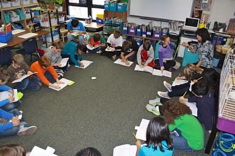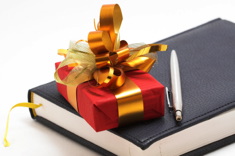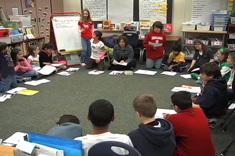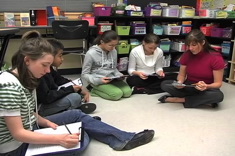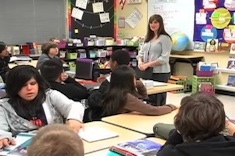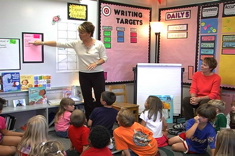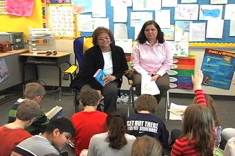All of this week’s suggestions for closing out the school year require planning ahead. How far ahead? Often all the way back to the first day of school, and many require a bit of writing or photography throughout the year. But the payoffs are huge – not only in the final keepsakes that students and teachers create, but in the enduring reminders of all the personal and community growth each year in our classrooms.
At the beginning of the year, the children go through the process of creating “hopes and dreams.” Examples include “I hope I learn to read books ” or “I hope I learn to count to 100 ” or “I hope I make lots of friends.” At the end of the year, the children think about who has helped them to reach their hopes and dreams. Each creates a “thank you” for that person, or persons, differentiated in the form of a note, drawing, voice message, etc. This activity helps children learn to balance personal determination in reaching hopes and dreams with a gratefulness and appreciation for others.
Diane Fee of Inver Grove, Minnesota
At the beginning of the year, I take a snapshot of each student and ask them to make a list of 20 words to describe themselves. Using Wordle, I make a page using the student’s name and all the words they use to describe themselves. We post them, along with their photos in our room for a while. Then I take them down and store them. At the end of the year, I take another photo of them and ask for 20 words to describe themselves. I make another Wordle sheet, attach their picture, and laminate the one from the beginning of the year alongside of the one from the end of the year. This way, students can see how much they have grown through their own eyes!
Lori Partin of Loveland, Ohio
In the fall I give my class a paper written vertically naming their favorites (i.e., favorite friend, favorite book, favorite author, song, movie). The paper is folded in a hot dog fold with “Fall” written on the right-hand side. We pull them back out in the spring (I have folded their fall responses over so they cannot be seen), and students once again create responses for their favorites. At the same time, we all open ours up and compare our fall responses with our spring responses. We find that MANY things have changed as we’ve grown. There is also a tendency to compare the overall neatness and handwriting used at the beginning and the end of the year. My students love this as one of our culminating activities!
Karen Boyd of Hilliard, Ohio
At the start of the school year I ask my students to look in mirrors and draw a picture of themselves. Then throughout the year we talk about the first week of school and what we’ve learned during the school year. At the end of the year I ask my students to draw a picture of themselves again and share how they changed or how they are different compared to the first week of school. It’s wonderful to see the confidence that they have gained in who they are as learners. Some realize that they are really not much different from who they were at the start of the year – they are just more open in trying new things or they’re really not afraid anymore.
Sabrinna Cooper of Deer Park, Texas
At the beginning of the year I give each child a memory box to store some of their favorite memories from first grade. We paint and decorate them together. Throughout the year the children decide what they would like to store in them. All year long I read various books aloud and share personal stories about some of the memories I am storing in my box for this year’s class. We create kites together and the children invite their families to a picnic. We share our memory books and the children fly their kites with their families and friends. We add this memory as their final memory for their book.
Yvonnee Gaynor of Alexandria, Virginia
At the beginning of the year I read the book Finding the Green Stone to my students and present each student with their own green stone, along with the challenge of keeping their stone shining! We brainstorm ways that we can keep our stones shining by practicing compassionate behavior within our school community. Towards the end of the year we brainstorm ideas for how we can take our compassionate behavior home and continue to keep our green stone shining. Students periodically record their individual behaviors that have contributed to making their green stones shine. This is a wonderful booklet to send home for kids to reflect back and to continue journaling about “how they want to be.”
Dorene Tieche of St. Charles, Illinois
I collect small stuffed animals each summer at garage sales. In the fall I place them above my bulletin boards. The students ask what they are for and I tell them, “They are memory keepers and they watch and remember all the good times you will have in this room. On the last day of school, each student takes home a “memory keeper” to help them remember third grade. When a child is sick for a long time or there is a tragedy like a death in the family, students choose one of the stuffed animals to give another as a token of our care. During the year, some students like to write from the point of view of one of our “memory keepers.” All of these simple activities promote our sense of community and caring for one another.
Marlyn Payne of Evanston, Illinois
I have always taken pictures and created a timeline line with students from the first day to the last day. During the last two weeks of school each child gets a picture or two and then writes a description of what was happening. We put all the “stories” into a YEARBOOK. Each student gets a copy and one copy is kept in the class library. The first day of school the following August. I use the book to provide an overview of what we will be doing during the year. I kept the class copies for years. The students loved to find family members and the books were a great favorite. We also had an autographing party the day the kids got to take their copies home – a fun way to end the year with a keepsake filled with memories!
Angela Winger of Monmouth, Illinois
My favorite activity is called “Marbleous Moments.” All during the year I fill up a jar each time my student makes a wonderful connection, a profound statement, a great discovery, hits a milestone, or overcomes an obstacle in reading. At the end of the year I take out the marbles and wrap them in netting and ribbon. On the last day of school, we sit in a circle and I present a marble to each of them remembering an event. In a way the jar represents our reading community, and the emptying of the jar represents releasing the responsibility for their reading back to them. It is always a little teary for me, but a great celebration for our community of learners.
Jae Goodwin of Framingham, Massachusetts
My favorite end-of-year activity was for my first-grade students to read their growth journals. First graders grow so much throughout the year in their writing abilities, so I decided to create a special journal. On the first school day of each month, I gave the children their special journals. They wrote about anything they wished. I explained that this would be a book they would read when they are old to know what was happening in their minds when they were in first grade. They drew pictures and wrote any genre they wish. We selected one day during the last week of the school year for my students to share these with their buddy class of older students. The last page was set aside for all who read it to leave comments. My first-grade students were always so excited to celebrate their growth in writing!
Tamala Brown of Charlotte, North Carolina
At the beginning of the year I have my 6th graders fill out a survey describing themselves: the things they like, best friends, favorite foods, etc. They decorate a large manila envelope with their name in an acrostic poem, then fill it with artifacts that relate to the survey. They share this “time capsule” in small groups introducing themselves. The groups are recorded on the back of the envelope for use in the future. At the end of the year, we pull out the time capsules. The students complete the same survey as they did at the beginning of the year, and they get in the same groups. They compare the changes they have encountered over the year from the two surveys and explore the artifacts they brought (and have been looking for all year). The surveys reveal the changes most 6th graders experience. Laughter and conversation fill the room as they see for themselves how much they have grown. Once the excitement is over, students write about this experience and include goals for the next school year. These are shared with the class in the “Writers’ Chair.”
Deborah Mozingo of Trinity, North Carolina
At the beginning of the school year in my kindergarten classroom, I put 12 pieces of laminated construction paper up on my cupboard doors, labeled with the months of the year. As the year progresses, I put up pictures each month of our year together: field trips, author visits, favorite books we’ve loved, etc. At the end of the year, I take down the picture filled pages, make them into a big book, and read my students the story of Room 4. They love it! Our book then goes into the book area for the children to read again during the last days of school.
Deb Killough of Omaha, Nebraska
At the beginning of the year I ask my students to pair up with someone they don’t know really well yet. Then as a class we compile of list of interview questions they would like to know about each other. They interview their partner, have their picture taken together, and write an introduction of their new friend. I put these up and they all enjoy reading them and finding things they have in common or want to learn more about. At the end of the year I have them return to these pieces with their partner and reflect on how much better they all know each other now. They then write a second introduction to attach to a new picture. It is so fun to see how their writing has changed and how their relationships have grown.
Anne Marie Chow of Taipei, Taiwan

